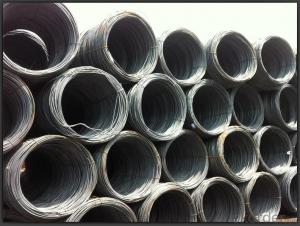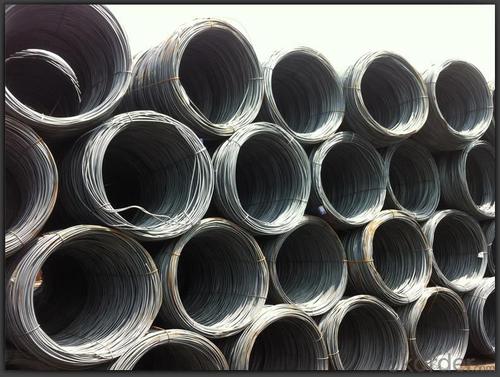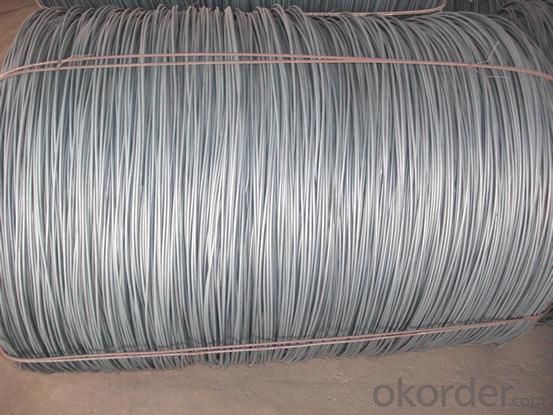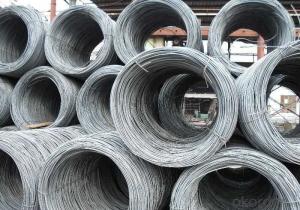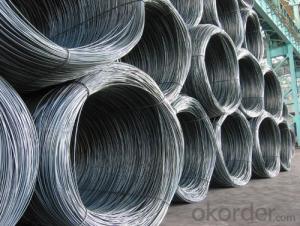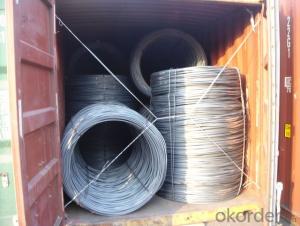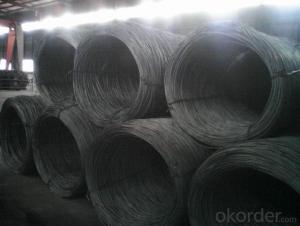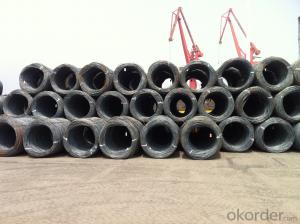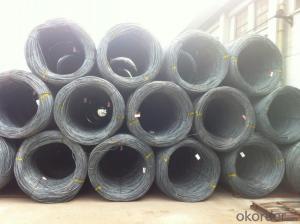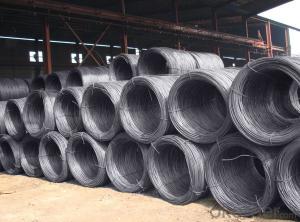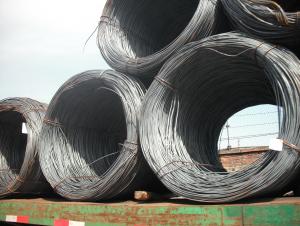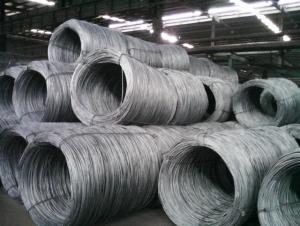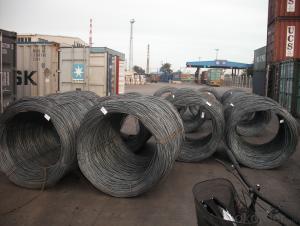Wire Rod Hot Rolled High Quality SAE1008B
- Loading Port:
- Tianjin
- Payment Terms:
- TT OR LC
- Min Order Qty:
- 25 m.t.
- Supply Capability:
- 2000000 m.t./month
OKorder Service Pledge
OKorder Financial Service
You Might Also Like
Specification
Product Description:
OKorder is offering Wire Rod Hot Rolled High Quality SAE1008B at great prices with worldwide shipping. Our supplier is a world-class manufacturer of steel, with our products utilized the world over. OKorder annually supplies products to European, North American and Asian markets. We provide quotations within 24 hours of receiving an inquiry and guarantee competitive prices.
Product Applications:
After Wire Rod Hot Rolled High Quality SAE1008B shaped into coil and delivery as finished product, including round, square, rectangular, hexagonal and so on. Since most of the products are round, it is generally called wire rod. Carbon steel wire rod is widely used in construction and manufacturing. Carbon steel wire rod is mainly used for reinforcement of reinforced concrete and welded structure or reprocessed (roberts , nail, etc.) materials, especially used to produce wire drawing, welding electrode, nails, spring, electronic, precise machinery parts and so on.
Product Advantages:
OKorder's Wire Rod Hot Rolled High Quality SAE1008B are durable, strong, and resist corrosion.
Main Product Features:
· Premium quality
· Prompt delivery & seaworthy packing (30 days after receiving deposit)
· Corrosion resistance
· Can be recycled and reused
· Mill test certification
· Professional Service
· Competitive pricing
Product Specifications:
Manufacture: Hot rolled
Grade: SAE1008 SAE 1006
Certificates: ISO, SGS, BV, CIQ
Diameter: 5.5mm, 6.5mm, 7mm,8mm,9mm,10mm,12mm,14mm, as per customer request
Packaging: Export packing, nude packing, bundled
Grade | Chemical Composition (%) | |||||
C | Mn | S | P | Si | B | |
SAE1008B | 0.10max | 0.32max | 0.045max | 0.040max | 0.30max | 0.0008min |
Mechanical properties | ||||||
Yield strength(N/mm2) | Tensile strength(N/mm2) | Elongation (%) | ||||
≥195 | 350-380 | ≥32 | ||||
FAQ:
Q1: Why buy Materials & Equipment from OKorder.com?
A1: All products offered byOKorder.com are carefully selected from China's most reliable manufacturing enterprises. Through its ISO certifications, OKorder.com adheres to the highest standards and a commitment to supply chain safety and customer satisfaction.
Q2: How soon can we receive the product after purchase?
A2: Within three days of placing an order, we will begin production. The specific shipping date is dependent upon international and government factors, but is typically 7 to 10 workdays.
Q3: Can stainless steel rust?
A3: Stainless does not "rust" as you think of regular steel rusting with a red oxide on the surface that flakes off. If you see red rust it is probably due to some iron particles that have contaminated the surface of the stainless steel and it is these iron particles that are rusting. Look at the source of the rusting and see if you can remove it from the surface.
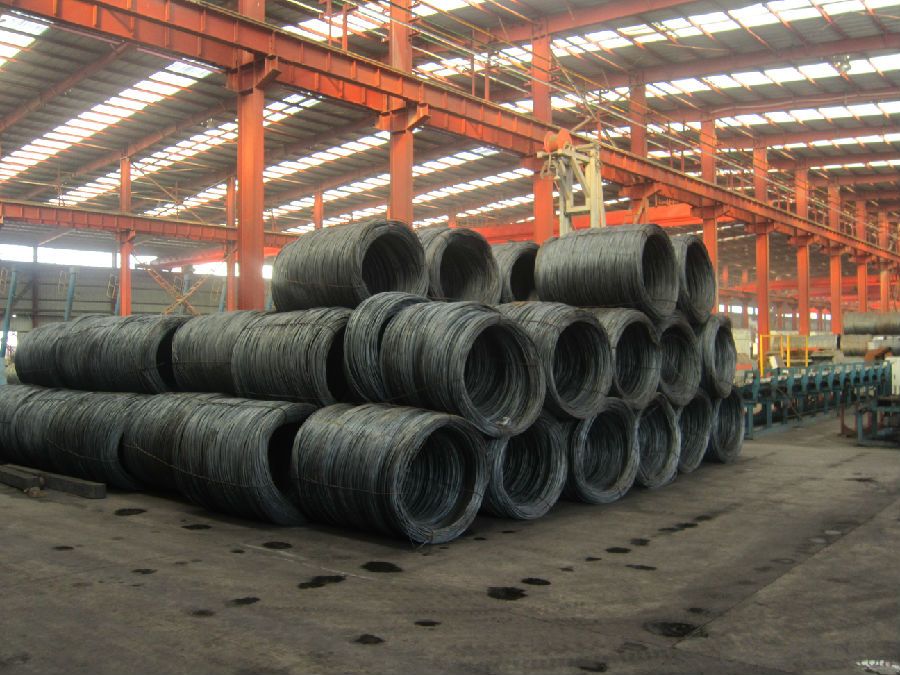
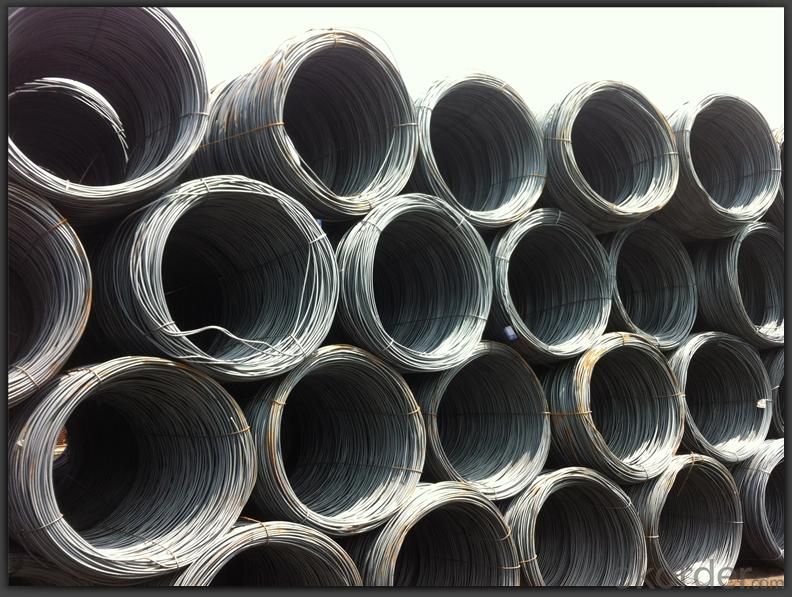
- Q: What are the common heat treatment processes for steel wire rod?
- The common heat treatment processes for steel wire rod include annealing, normalizing, quenching, and tempering.
- Q: What are the different surface finishes of steel wire rod available?
- The different surface finishes of steel wire rod available include black, pickled and oiled, galvanized, and coated with zinc or other protective coatings.
- Q: What are the main factors affecting the worker safety in steel wire rod production?
- The main factors affecting worker safety in steel wire rod production include: 1. Machinery and equipment: The operation of heavy machinery and equipment poses risks such as entanglement, crushing, and falling objects. Regular maintenance, training, and proper guarding of machinery are crucial to ensure worker safety. 2. Hazardous materials: Steel wire rod production involves the handling and processing of potentially hazardous substances such as chemicals, gases, and hot metals. Adequate training, usage of personal protective equipment (PPE), and implementation of proper handling procedures are essential to minimize exposure and prevent accidents. 3. Manual handling and ergonomics: Workers in this industry often engage in physically demanding tasks such as lifting heavy objects, bending, and repetitive motions. Failure to provide proper training, ergonomic workstations, and regular breaks can lead to musculoskeletal disorders and injuries. 4. Heat and fire hazards: Steel wire rod production involves high temperatures, molten metal, and open flames, which pose significant fire and burn hazards. Implementation of effective fire prevention and suppression systems, heat-resistant clothing, and proper training are essential to ensure worker safety. 5. Noise and vibration: Continuous exposure to high levels of noise and vibrations from machinery and equipment can lead to hearing loss, fatigue, and other long-term health issues. Regular noise monitoring, engineering controls, and provision of hearing protection are necessary to protect workers from these hazards. 6. Slip, trip, and fall hazards: The presence of slippery surfaces, uneven floors, and clutter in the production area increases the risk of slip, trip, and fall accidents. Regular housekeeping, proper signage, and use of anti-slip flooring can help mitigate these hazards. 7. Electrical hazards: Steel wire rod production involves the use of electrical equipment, which can pose risks of electric shock, fires, and explosions. Adequate training, regular inspections, and compliance with electrical safety standards are essential to prevent such incidents. Overall, a comprehensive approach that includes proper training, implementation of safety protocols, regular risk assessments, and ongoing monitoring is necessary to ensure worker safety in steel wire rod production.
- Q: What are the common industry competencies for steel wire rod manufacturers?
- The common industry competencies for steel wire rod manufacturers include expertise in metallurgy, production processes, quality control, and product development. They should have a deep understanding of steel properties, heat treatment, and alloying techniques to ensure the desired mechanical properties of the wire rod. Additionally, they should possess advanced manufacturing capabilities, such as wire drawing, rolling, and finishing, to produce wire rod with precise dimensions and surface quality. Quality control measures, including testing and inspection, are crucial to ensure compliance with industry standards and customer requirements. Lastly, continuous product development and innovation are essential to meet evolving market demands and stay competitive in the industry.
- Q: How is steel wire rod used in the manufacturing of wire forms for suspension bridges?
- Steel wire rod is used in the manufacturing of wire forms for suspension bridges as it serves as the primary material for constructing the bridge cables. These cables are crucial in supporting the weight of the bridge deck, providing stability, and allowing for the bridge to span long distances. The wire rod is carefully processed and shaped into high-tensile strength wires, which are then bundled together to form the main cable. This cable is then attached to the bridge towers and anchors, creating a strong and durable structure capable of withstanding the forces and loads experienced by suspension bridges.
- Q: What are the different types of steel wire rod finishes for improved wear resistance in high-temperature environments?
- There are several types of steel wire rod finishes that can enhance wear resistance in high-temperature environments. Some common finishes include galvanized, stainless steel, and heat-treated. Galvanized finishes involve coating the wire rod with a layer of zinc, providing corrosion resistance and improved durability. Stainless steel finishes are highly resistant to corrosion and oxidation, making them suitable for high-temperature applications. Heat-treated finishes involve subjecting the wire rod to heat and then rapidly cooling it, resulting in increased hardness and wear resistance.
- Q: What are the different types of steel wire rod surface defects and their impact?
- Steel wire rods can exhibit various surface defects, each of which has its own distinct effect on the quality and performance of the product. The ensuing list highlights some commonly encountered defects and their corresponding consequences: 1. Scale: During manufacturing, steel wire surfaces may develop scale, an oxide layer. This layer can manifest as a thick, flaky coating or a thin, tightly adhered film. Scale can detrimentally impact the wire rod's surface finish and corrode its resistance. 2. Pits: Small depressions or cavities, termed pits, can arise on the wire rod's surface. These pits result from impurities or inclusions in the steel or mechanical damage during processing. Pits can diminish the wire rod's strength and integrity, making it prone to failure when subjected to stress. 3. Scratches and gouges: Physical marks, namely scratches and gouges, can mar the wire rod's surface due to contact with abrasive surfaces or mishandling. Such defects create points of stress concentration, compromising the wire rod's strength and raising the risk of fracture or breakage. 4. Laps and seams: Laps and seams are surface irregularities or discontinuities that often occur due to improper rolling or handling. These flaws can affect the wire rod's dimensional accuracy and diminish its overall strength and ductility. 5. Decarburization: When exposed to high temperatures during processing, the wire rod's surface layer may experience decarburization, resulting in the loss of carbon. This can lead to a softer and weaker surface layer, reducing wear resistance and fatigue strength. 6. Corrosion: Chemical reactions with the environment cause corrosion, which leads to the deterioration of the wire rod's surface. This corrosion can manifest as rust or other oxidation forms. Corrosion significantly diminishes the wire rod's lifespan and performance, especially when exposed to moisture or corrosive substances. In general, these surface defects have adverse effects on the quality, strength, and durability of steel wire rods. Implementing proper quality control measures and inspection techniques is crucial to identify and mitigate these defects, ensuring that the wire rods meet specified requirements and perform optimally in their intended applications.
- Q: What are the main factors influencing the choice of steel wire rod surface finish?
- The choice of steel wire rod surface finish is influenced by several factors, each of which plays a significant role in determining the appropriate finish for a particular application. One of the main factors is the intended use of the wire rod. Different surface finishes offer varying levels of corrosion resistance, lubricity, and adhesion properties, which are crucial considerations in determining the suitability of the wire rod for a specific application. For example, a wire rod used in a corrosive environment may require a surface finish that provides enhanced resistance to rust and oxidation. Another factor influencing the choice of surface finish is the desired aesthetic appearance. Certain industries, such as automotive or consumer goods, may have specific requirements for the visual appeal of the wire rod. In such cases, finishes that offer a smooth, polished, or decorative appearance may be preferred. The mechanical properties required for the wire rod's application also play a role in determining the surface finish. Some finishes, such as a bright or polished surface, can improve the wire rod's yield strength, ductility, and fatigue resistance. These properties are vital in applications that involve high-stress conditions or require flexibility and durability. Cost considerations also come into play when selecting the surface finish. Some finishes require additional processing steps, such as pickling, coating, or electroplating, which can increase the overall cost of the wire rod. Therefore, it is essential to balance the desired surface finish with the cost-effectiveness of the manufacturing process. Lastly, environmental and regulatory factors can influence the choice of surface finish. Certain finishes may contain hazardous substances or require specific disposal methods, which can impact the environmental footprint of the wire rod production. Compliance with industry standards and regulations is crucial to ensure the safety and sustainability of the finished product. In conclusion, the choice of steel wire rod surface finish is influenced by factors such as intended use, aesthetic requirements, mechanical properties, cost considerations, and environmental considerations. By carefully considering these factors, manufacturers can select the most appropriate surface finish that aligns with the specific requirements of the application and ensures the optimal performance and quality of the wire rod.
- Q: How is steel wire rod recycled?
- Steel wire rod is typically recycled through a process called electric arc furnace (EAF) steelmaking. In this process, the steel wire rod is melted down in an electric arc furnace, where impurities are removed. Once purified, the molten steel is cast into new wire rod shapes or other steel products. This recycling method helps conserve natural resources, reduces waste, and promotes sustainability in the steel industry.
- Q: What are the different straightening methods for steel wire rod?
- There are several different straightening methods for steel wire rods, each designed to achieve specific results based on the desired level of straightness and the type of wire being processed. Some of the most common straightening methods used in the industry include: 1. Mechanical straightening: This method involves passing the wire rod through a series of straightening rolls or dies that are positioned at various angles. The rolls or dies apply pressure to the wire, gradually bending it back into a straight shape. Mechanical straightening is commonly used for low carbon steel wire rods. 2. Thermal straightening: In this method, the wire rod is heated to a specific temperature and then cooled rapidly, causing the metal to contract and straighten. The wire is usually passed through a series of water or air cooling chambers to achieve the desired straightness. Thermal straightening is typically used for medium to high carbon steel wire rods. 3. Hydraulic straightening: This method utilizes hydraulic cylinders to apply pressure to the wire, straightening it by bending it in the opposite direction of its natural curve. Hydraulic straightening can be used for various types of steel wire rods, but it is especially effective for high-strength wires. 4. Rotary straightening: Also known as rotary swaging, this method involves placing the wire rod in a rotating drum or cage that contains a series of tapered rolls. As the wire passes through the rolls, it is gradually straightened due to the forces exerted by the rotating rolls. Rotary straightening is commonly used for stainless steel wire rods and other high-alloy materials. 5. Combination methods: Some manufacturers use a combination of different straightening methods to achieve the desired results. For example, a wire rod may undergo initial mechanical straightening followed by thermal straightening to further improve its straightness. It is important to note that the choice of straightening method depends on various factors such as the type of steel wire rod, its diameter and tensile strength, and the desired level of straightness. Additionally, each method has its own advantages and limitations, so it is crucial to select the most suitable method based on the specific requirements of the wire rod application.
Send your message to us
Wire Rod Hot Rolled High Quality SAE1008B
- Loading Port:
- Tianjin
- Payment Terms:
- TT OR LC
- Min Order Qty:
- 25 m.t.
- Supply Capability:
- 2000000 m.t./month
OKorder Service Pledge
OKorder Financial Service
Similar products
Hot products
Hot Searches
Related keywords
